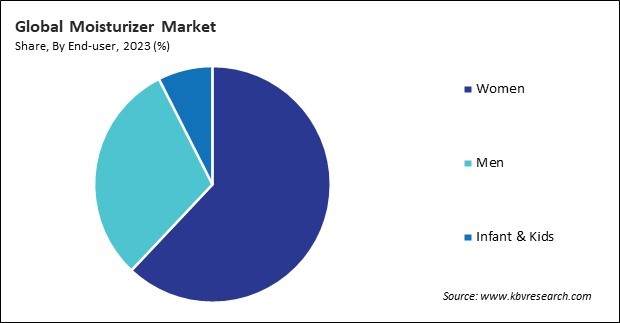“Global Moisturizer Market to reach a market value of USD 15.4 Billion by 2031 growing at a CAGR of 5.1%”
The Global Moisturizer Market size is expected to reach $15.4 billion by 2031, rising at a market growth of 5.1% CAGR during the forecast period. In the year 2023, the market attained a volume of 2,82,199.06 thousand units (50 ML), experiencing a growth of 10.8% (2020-2023).
Asia-Pacific region encompasses many climates, from tropical to temperate. Consumers in different climates have varying skincare needs, influencing the types of moisturizers they prefer, such as lightweight gels for humid climates and richer creams for dry or cold environments. Thus, the Asia Pacific region acquired 40.2% revenue share in the market 2023. In the terms of volume, the Asia Pacific region would attain a volume of 2,08,559.20 thousand units (50 ML) by 2031. Economic growth in many Asia-Pacific countries has led to rising disposable incomes, allowing consumers to spend more.

As awareness grows about the importance of skincare for overall health and appearance, consumers become more informed about the benefits of moisturizers. They understand that moisturizers help maintain skin hydration, improve texture, prevent dryness, and protect against environmental stressors.
Additionally, in addition to experiential retail and influencer marketing, promotional strategies have been instrumental in attracting the middle class to premium skincare products. Hence, the increasing disposable income is a significant factor driving the expansion of the market.
However, the increasing DIY (do-it-yourself) skincare trend is negatively impacting the demand for commercial moisturizers. As more consumers become interested in creating their skincare products at home, the reliance on store-bought moisturizers decreases. Therefore, the rise of DIY skincare presents challenges for commercial moisturizer brands, hampering the market's growth.
On the basis of form, the market is classified into cream, lotion, and gel. The lotion segment recorded 32.4% revenue share in the market in 2023. In terms of volume the lotion segment would attain a volume of 1,39,939.30 thousand units (50 ML) by 2030. The balanced, medium consistency of lotions, which is neither excessively thick nor thin, renders them appropriate for an extensive array of skin types, including dry to normal.
By end-user, the market is fragmented into men, women, and infant & kids. The women segment procured 62% revenue share in the market in 2023. In the terms of volume, the women segment would attain a volume of 2,73,223.22 thousand units (50 ML) by 2030. Women are often targeted with anti-aging moisturizers, including ingredients like retinol, peptides, vitamin C, and hyaluronic acid.

Based on type, the market is bifurcated into face moisturizer and body moisturizer. The face moisturizer segment garnered 56.9% revenue share in the market in 2023. In terms of volume, the face moisturizer segment would attain a volume of 1,66,669.94 thousand units (50 ML) by 2031. This segment includes various products, such as creams, gels, lotions, serums, and oils.
Free Valuable Insights: Global Moisturizer Market size to reach USD 15.4 Billion by 2031
Region-wise, the market is analyzed across North America, Europe, Asia Pacific, and LAMEA. The North America segment held 25.5% revenue share in the market in 2023. In terms of volume, the North America region would attain a volume of 1,12,600.25 thousand units (50 ML) by 2031. of North America, particularly the United States, often sets global beauty trends. Consumer preferences for clean, natural, and innovative skincare products influence the region's development and marketing of moisturizers.
| Report Attribute | Details |
|---|---|
| Market size value in 2023 | USD 10.4 Billion |
| Market size forecast in 2031 | USD 15.4 Billion |
| Base Year | 2023 |
| Historical Period | 2020 to 2022 |
| Forecast Period | 2024 to 2031 |
| Revenue Growth Rate | CAGR of 5.1% from 2024 to 2031 |
| Quantitative Data | Volume in Thousand Units, Revenue in USD Billion, and CAGR from 2020 to 2031 |
| Number of Pages | 326 |
| Number of Tables | 670 |
| Report coverage | Market Trends, Revenue Estimation and Forecast, Segmentation Analysis, Regional and Country Breakdown, Porter’s 5 Forces Analysis, Company Profiling, Companies Strategic Developments, SWOT Analysis, Winning Imperatives |
| Segments covered | Type, Form, End-user, Region |
| Country scope |
|
| Companies Included | L'Oreal S.A., Unilever PLC, The Procter & Gamble Company, Johnson & Johnson, Kao Corporation, The Estee Lauder Companies, Inc., Shiseido Company Limited, Beiersdorf AG, Henkel AG & Company, KGaA, and Coty, Inc. |
By Type (Volume, Thousand Units, USD Billion, 2020-2031)
By Form (Volume, Thousand Units, USD Billion, 2020-2031)
By End-user (Volume, Thousand Units, USD Billion, 2020-2031)
By Geography (Volume, Thousand Units, USD Billion, 2020-2031)
This Market size is expected to reach $15.4 billion by 2031.
Increasing awareness and concerns about skincare are driving the Market in coming years, however, Increasing DIY (do-it-yourself) skincare trends restraints the growth of the Market.
L'Oreal S.A., Unilever PLC, The Procter & Gamble Company, Johnson & Johnson, Kao Corporation, The Estee Lauder Companies, Inc., Shiseido Company Limited, Beiersdorf AG, Henkel AG & Company, KGaA, and Coty, Inc.
In the year 2023, the market attained a volume of 2,82,199.06 thousand units (50 ML), experiencing a growth of 10.8% (2020-2023).
The Cream segment is leading the Market by Form in 2023; thereby, achieving a market value of $6.4 billion by 2031.
The Asia Pacific region dominated the Market by Region in 2023, and would continue to be a dominant market till 2031; thereby, achieving a market value of $6.4 billion by 2031.
Our team of dedicated experts can provide you with attractive expansion opportunities for your business.

 Drivers
Drivers
 Restraints
Restraints
 Opportunities
Opportunities
 Challenges
Challenges
